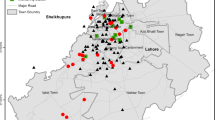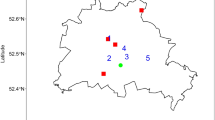Abstract
Purpose
Asthmatics are adversely affected by the presence of air pollutants, the concentrations of which can nowadays be measured. However, the utility of this information in clinical practice has not been defined in a group of asthmatics in stable condition. Our objective was to determine what impact the level of air pollutants had on the control of their asthma and the degree of airway inflammation.
Methods
We performed a cross-sectional study of adult asthmatics in stable condition. From the regional environmental authority, we obtained the concentrations of ambient nitric oxide (NO2), ozone (O3), suspended particulate matter up to 10 micrometers in diameter (PM10) and sulphur dioxide (SO2) at fixed geographical points. Disease control was assessed using asthma control test (ACT) scores, and airway inflammation using fraction of exhaled nitric oxide (FeNO) values. Correlation and linear regression studies were performed using ACT scores as the dependent variable.
Results
The study included 99 asthmatics, aged 39 years (SD 8), 55 % women. Mean ACT value was 17.2 (SD 6.5), and FeNO 33.7 (SD 16). Of the pollutants studied, only NO2 was correlated with ACT scores (CC = 0.45, p < 0.001). We found no relationship between pollutants and airway inflammation. Multivariate analysis showed that ACT score was predicted by ambient air NO2 concentration and, to a lesser extent, mean FeNO.
Conclusions
Information on the concentration of ambient NO2 in our environment can help the clinician to interpret the evolution of asthmatic patients.
Similar content being viewed by others
References
Jovanovic Z, Bonnelykke K, Hvidberg M et al (2012) Long term exposure to air pollution and asthma hospitalizations in older adults: a cohort study. Thorax 67:6–11
Iskandar A, Jovanovic Z, Bonnelykke K et al (2012) Coarse and fine particles but not ultrafine particles in urban air trigger hospital admissions for asthma in children. Thorax 67:252–257
Nishimura K, Galender JM, Roth LA et al (2013) Early life air pollution and asthma risk in minority children. Am J Respir Crit Care Med 188:309–318
Air quality and health: Fact sheet N°313 (2011) http://www.who.int/mediacentre/factsheets/fs313/en/. Accessed 14 Feb 2015
Miller MR, Hankinson J, Brusasco V et al (2005) ATS/ERS task force : standardization os spirometry. Eur Respir J 26:319–338
Vega JM, Badia X, Badiola C et al (2007) Validation of the spanish versión of the asthma control test (ACT). J Asthma 44:867–872
Brandt SJ, Perez L, Künzil N et al (2012) Cost of childhood due to traffic-related pollution in two California communities. Eur Respir J 40:363–370
Faustini A, Stafoggia M, Colais P et al (2013) Air pollution and multiple acute respiratory outcomes. Eur Respir J 42:304–313
Gonzalez Barcala FJ, Pertega S, Garnelo L et al (2013) Truck traffic related air pollution associated with asthma symptoms in young boys: a cross sectional study. Public Health 127:275–281
Jacquemin B, Kauffman F, Pin I et al (2012) Air pollution and asthma control in the epidemiological study on the genetics and environmental asthma. J Epidemiol Community Health 66:796–802
Martins PC, Valente J, Papolla AL et al (2012) Airways changes related to air pollution exposure in wheezing children. Eur Respir J 39:246–253
McCreanor J, Culligan P, Nieuwenhuijsen MJ et al (2007) Respiratory effects of exposure to diesel traffic in persons with asthma. N Engl J Med 357:2348–2358
Elisabete S, Tetelbom R, Archanjo A et al (2012) Los contaminantes atmosfericos urbanos son factores de riesgo significativos para el asma y la neumonia en niños:influencia del lugar de medicion de los contaminantes. Arch Bronconeumol 48:389–395
Conflict of interest
The authors declare that they have no conflict of interest.
Author information
Authors and Affiliations
Corresponding author
Rights and permissions
About this article
Cite this article
Fernandez, R., Ariza, M., Iscar, M. et al. Impact of Environmental Air Pollutants on Disease Control in Asmathic Patients. Lung 193, 195–198 (2015). https://doi.org/10.1007/s00408-015-9695-9
Received:
Accepted:
Published:
Issue Date:
DOI: https://doi.org/10.1007/s00408-015-9695-9




